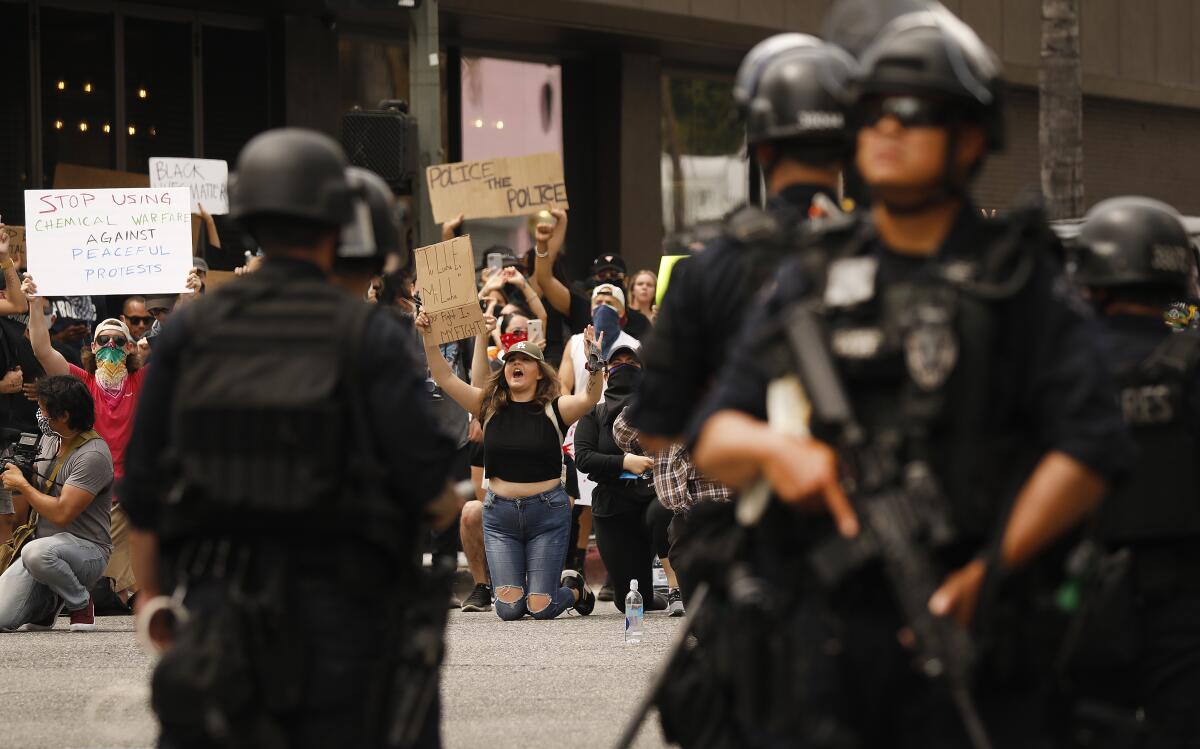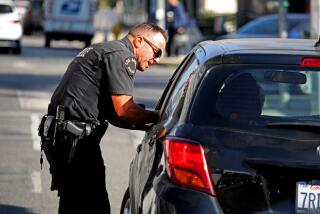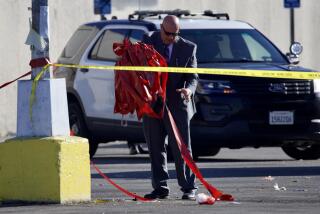As social unrest swept L.A. a curious trend emerged: Calls for police plunged

As social unrest swept across Los Angeles this month, police dispatchers were hit with a curious, if brief, trend.
Calls for service handled by officers — incidents ranging from loud parties and fireworks to domestic disputes and traffic stops — declined nearly by half during the two-week demonstration period. That means each day there were 2,000 fewer calls for police compared with the department’s typical workload, according to a Times analysis of dispatch data.
The timing of the dramatic drop in calls was unmistakable: It began on May 27, when protesters angry over the killing of George Floyd clashed with police in downtown Los Angeles and continued during the nearly two weeks of demonstrations. Police call levels returned to normal only around June 9, the day of Floyd’s funeral, the records show.
It’s unclear what precisely led to the drop in the roughly 5,000 calls that officers respond to each day. They fell in all police districts and among the most common types of cases, The Times analysis shows.
Perhaps the city was distracted, police say.
“It would seem that during the high protest periods, residents were not calling police, partly distracted by what they saw on TV, partly perhaps because crime and disorder issues in neighborhoods abated for the period, and perhaps because such low-priority issues seemed petty,” said Capt. Paul Vernon, a veteran LAPD commander who heads the department’s Compstat Division, a unit that uses data to track and map crime.
The decline included typical complaints over trespassing, loud parties and minor hit-and-run accidents. Those types of calls decreased by 80% during the protest period. So too did traffic stops by officers.
Even the number of calls to quell the use of illegal fireworks — a hot topic in coronavirus-era Los Angeles — came crashing down.
Police suspect the demonstrations, some of which involved violence and looting and prompted a countywide curfew, sparked a combination of societal factors that changed their policing, if only temporarily.
Another factor contributing to the steep drop in calls for service was the behavior of the police themselves. They sometimes call for backup support when initiating investigations, and those calls are included in the data. But since many officers were shifted from their normal duties to monitor protests officers made fewer calls related to their own investigations.
Whatever the reasons, the decrease in calls across Los Angeles appeared to be a unique phenomenon among major cities in California. The demonstrations in Los Angeles by some measures did appear larger and more intense and spanned more days than in other places.
The Times analyzed daily call volumes in San Francisco, San Jose, Sacramento and San Diego. Calls in those cities decreased much less dramatically, if at all, and over a shorter period of time — as protests flared across the country amid a resurgence of the Black Lives Matter movement.
One exception among those The Times examined was the much smaller neighboring city of Santa Monica, where a spike in calls corresponded to the large and destructive May 29 protests and looting in that city’s downtown area.
Santa Monica officers typically have handled about 265 calls each day this year. That more than doubled on May 29, where looters spent hours in the city’s upscale business district stealing items and setting several fires.
The trend in Los Angeles emerged when The Times turned to the dispatch logs, which are available on Mayor Eric Garcetti’s open-data portal, seeking to answer a burning question on the minds of many Angelenos this spring: Has there been an explosion of illegal fireworks?
The sporadic miniature explosions heard across the city this year has been a hot topic on social media and neighborhood platforms such as NextDoor, where residents have complained that the ruckus is more intense than a typical June run-up to July 4, disturbing them and scaring their dogs.
Before and after the protests period, the daily calls to LAPD about fireworks were much more common than normal. In the five months before June, the department has, on average, handled about 470 fireworks complaints. That more than doubled in 2020, according to the dispatch logs.
But during the protests the police received a brief respite from investigating fireworks complaints. That’s when they, like other incidents, nosedived.
There were roughly 325 fireworks complaints from May 24 to 28. Then the protests began in earnest in Los Angeles, and there were only about 30 complaints over the next 12 days.
They’ve since skyrocketed again, according to the data, surpassing what would be expected in June.
Fireworks complaints, of course, are only a tiny fraction of the work officers do each day on patrol. A significant share of it, about 44%, involves so-called code 6 calls, in which officers initiate their own incidents and inform dispatchers of their locations. They were cut in half during the protest period, falling from 2,350 on average per day to 1,180.
Calls about suspicious people, narcotics activity, landlord-tenant disputes and family squabbles all declined significantly during the demonstrations, and many have returned to normal volumes since.
Dustin DeRollo, a spokesman for the Los Angeles Police Protective League, the rank-and-file officers union, said the demonstrations meant vacations were canceled and significant numbers officers were called in to work. Those who remained on patrol had little time for proactive police work, he said.
“Due to the full mobilization of the department, neighborhood police patrols were left with a truly bare-boned police response,” he said.
More to Read
Start your day right
Sign up for Essential California for news, features and recommendations from the L.A. Times and beyond in your inbox six days a week.
You may occasionally receive promotional content from the Los Angeles Times.







